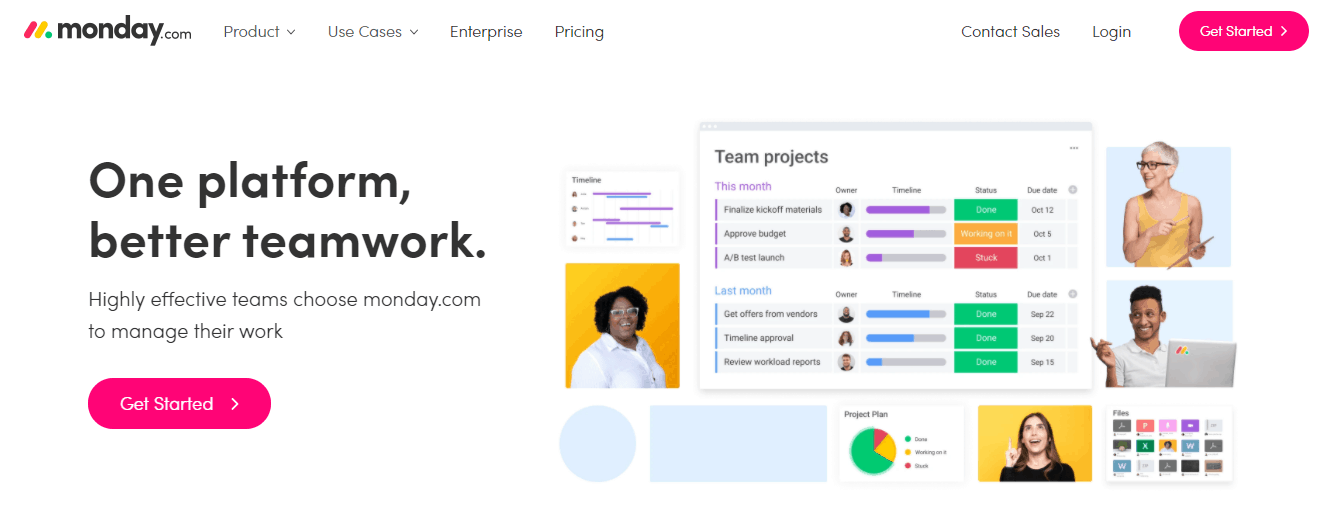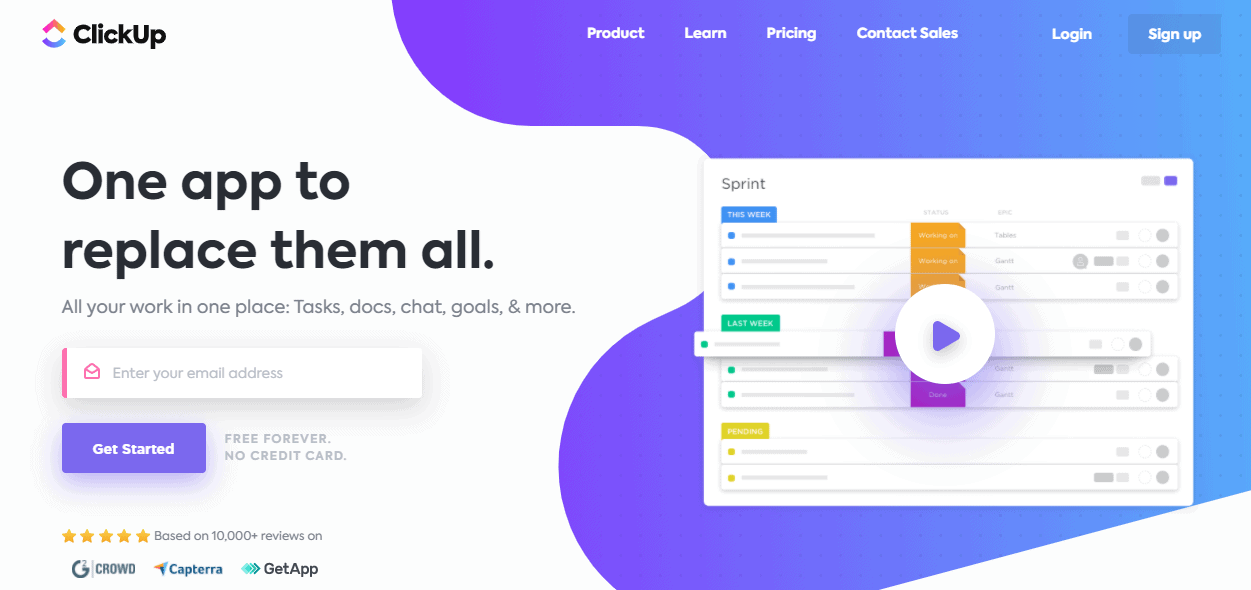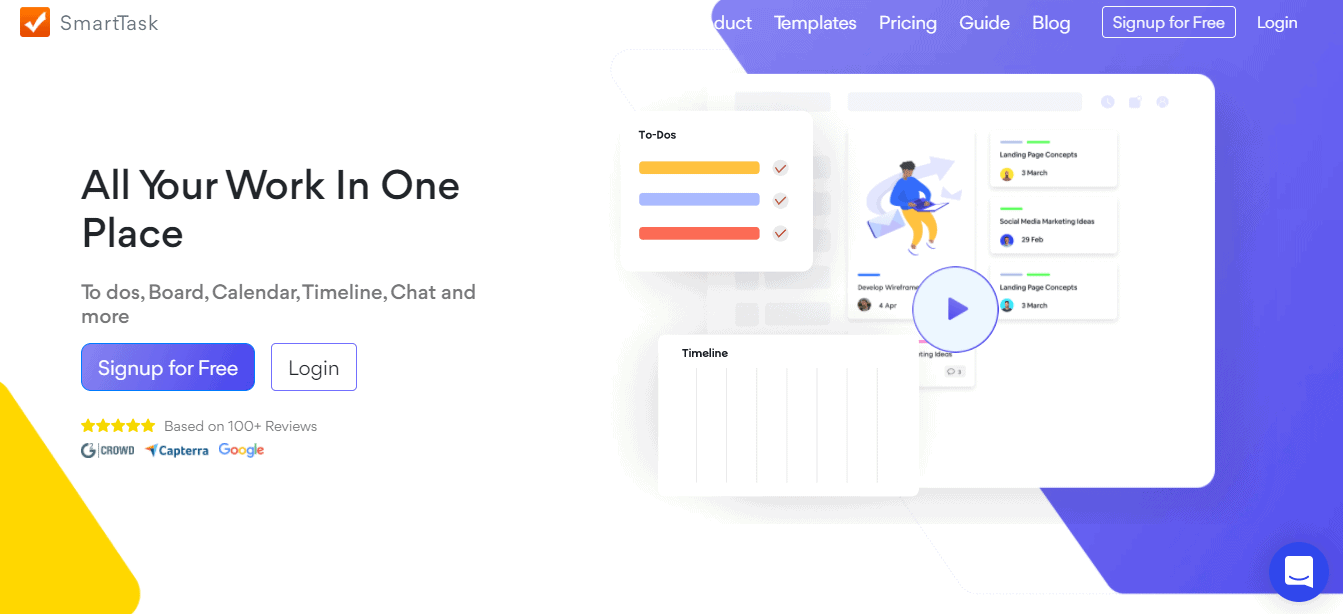Running a site can be a vastly different task depending on your situation. In cases where it’s your first site/business, most likely it’s a one-man show. As you grow your business, the same will be true for your site and before you know it, you’re working alongside a team of people and ultimately even more highly specialized teams down the line.
This is the reason there are so many project management tools on the market today. Every leader craves efficiency and these types of solutions will provide it.
We’ve compiled a list of the best ones available right now that will cover all your organizational needs. It’s very important to note that since the core purpose of each of the solutions we’ll mention is the same, there won’t be drastic differences between them, but we’ll look to point out those small details that make each app unique in its own right.
SmartTask
If we could describe SmartTask in one word it would be – streamlined. Where some other solutions try to specialize in one field or another, SmartTask looks to eliminate the need for any other software entirely. Chats, workflow (and any other) charts, staff management – it’s all here for you to utilize.
The user interface is highly adaptable with a plethora of available custom fields, charts, and views that make using it as much a personalized experience as it can be.
You’ll even be able to see the organization from a “birds’ eye” perspective overseeing all currently active projects on one page.
Not only will the text and video chat integrations make communication a breeze, but interaction with coworkers will also be brought to a new level with Karma Points. Aside from your personal evaluations of your colleagues, these will let them make evaluations among themselves in an accessible way giving you further insight into the office atmosphere and where there is room for improvement.
Monday

Monday is a popular option that’s been making the rounds in offices around the world for a while now. The main reason for its popularity is the ease of use both for those in charge of the projects and those handling the execution. Namely, everything can be organized and color-coded so that you’ll know exactly the task and the deadline simply by glancing over the charts.
Big groups will also be glad to know that the filtering options are done at a very high level and you’ll get to find what you’re looking for in a matter of moments even without resorting to the search bar.
If you’ve grown accustomed to a certain app, chances are you’ll be able to keep using it because Monday hosts an impressively large number of integrations for popular apps like Teams, Dropbox, Zoom, Google Drive, and many more, going so far as to let you create your own apps within the software. This type of approach will make the transition to Monday much easier for teams that already have work processes in place.
Asana

Asana is all about visualization. As the project and/or team lead you’ll get to set up entire projects and task within them as lists that can be further segmented for more detailed organization; Kanban boards that are viewed as columns; on calendars for those ever so important deadlines; and even a version of Gantt charts that displays a timeline with tasks that can be connected if one is dependent on another that came before.
Naturally, within these various views you’ll have options to assign tasks, due dates, add comments, etc. just like in any other project management app. While it can be used by teams of all sizes, the specifics and interface of Asana lend themselves best for smaller teams.
ClickUp

Similar to SmartTask we’ve already gone through, ClickUp looks to replace all your project management apps rather than just being one of them. The most interesting feature must be the option to import projects you’ve already started on a different app into ClickUp and simply go from there.
Another feature worth highlighting is the goals. Vaguer than projects and tasks, goals represent something you and your team(s) strive for – an example would be “raise sales 10% this quarter”. Goals are then broken down into targets that, once achieved, will result in accomplishing the aforementioned goal.
Wishup’s Employee Management App – The All-in-One Solution for Remote Teams

Running a business remotely? Manage your team with ease right from your phone using Wishup’s Employee Management App. This powerful tool makes employee management and task tracking seamless, putting your entire office in the palm of your hand.
Features:
- Easy Team Management: Track tasks, assign responsibilities, and get end-of-day reports to stay informed on what everyone’s working on.
- Time Tracking: Monitor time spent on tasks and get insights into employee utilization for efficient team management.
- Task Scheduling: Schedule tasks in advance and receive AI-powered task suggestions to optimize team productivity.
- Leave Tracking: Manage employee leave requests and absences effortlessly.
- Employee Utilization: See how effectively your team uses their time, with a built-in utilization tracker.
- Perfect for Remote Teams: Ideal for entrepreneurs and remote teams, making daily management and reporting clear, efficient, and accessible.
Download Wishup’s Employee Management App Today!
Google Tables

Everything with Google in its name has the power to immediately draw attention to itself and Google Tables are no different. The biggest advantage here is the seamless integration with every other Google service. This might seem redundant, but we all use these services daily, so having a platform that can bring them together, and do so better than most other apps, deserves attention.
On the other hand, Google Tables are still in the beta stage. Because of this, at this moment, with Google Tables, you’ll be getting a run of the mill app that has all the core features everyone else shares. However, Google pedigree gives them an abundance of potential which is the reason we’ve put them on the list.
Trello

Trello is a Wrike alternative that’s probably most responsible for people using a Kanban board organizing system as their preferred style. The app brought it into the spotlight and is still, years after, ahead of the competition in this particular regard.
Kanban organizes tasks in columns based on their status, the most obvious example would be: to-do>working on>finished. Tasks are represented as cards that move from left to tight as they progress through the stages. All the cards can be further customized with core attributes like color schemes or advanced ones like fading over time.
Because of the vertical view, Trello is an especially great option for phones and tablets where the screen format isn’t ideal for long horizontal charts.
Basecamp

Basecamp has been around for a while, so chances are, you’ve probably heard of them before. In the meantime, many new solutions have sprouted up, but this old-timer can still hold its own. All the usual features that have been overarching thus far are also present here. Two features, however, are distinctly unique.
The first of the two is the automatic check-in feature. These, if enabled, send premade questions to team members that can then quickly update you on their progress without you having to hang over their head.
The second is the unique visualization – the hill chart. The idea behind hill charts is to divide tasks between uphill ones (teams figuring out how to solve problems) and downhill ones (teams are executing solutions). Setting up tasks in this way lets supervisors know if there are any problematic areas on which to focus on.
Conclusion
We wouldn’t say the market is flooded with them but there certainly is an abundance of project management apps out there. It’s therefore understandable to get overwhelmed by it all. The ones we’ve highlighted are just the tip of the iceberg with each having at least one specific niche that could be uniquely interesting. Based on your needs, each of them represents a legitimate solution you won’t regret using.
